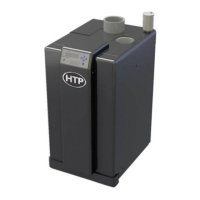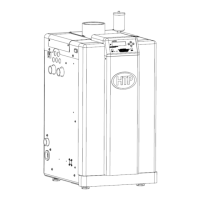lp-666 Rev. 003 Rel. 001 Date 2.25.20
16
Part 4 - Piping
Failure to follow the instructions in this section WILL VOID the
warranty and may result in property damage, severe personal
injury, or death.
Dielectric unions or galvanized steel ttings must not be used in a
system with this boiler. Doing so WILL VOID the warranty. Use only
copper, brass, or stainless steel ttings. Teon thread sealant must
be used on all connections.
Plumbing of this product should only be done by a qualied, licensed
plumber in accordance with all local plumbing codes. The boiler
may be connected to an indirect water heater to supply domestic
hot water. HTP oers indirect water heaters in either stainless steel
or glass-lined construction.
A. General Plumbing Information
The building piping system must meet or exceed the piping
requirements in this manual.
NOTE: The addition of a high temperature limiting device is
important if the boiler is used to indirectly heat domestic hot water.
B. Relief Valve
To avoid water damage or scalding due to relief valve operation:
• Discharge line must be connected to relief valve outlet and
run to a safe place of disposal. Terminate the discharge line
in a manner that will prevent possibility of severe burns or
property damage should the relief valve discharge.
• Discharge line must be as short as possible and the same
size as the valve discharge connection throughout its entire
length.
• Discharge line must pitch downward from the valve and
terminate at least 6” above the oor drain, making discharge
clearly visible.
• The discharge line shall terminate plain, not threaded, with
a material serviceable for temperatures of 375
o
F or greater.
• Do not pipe discharge to any location where freezing could
occur.
• No valve may be installed between the relief valve and boiler
or in the discharge line. Do not plug or place any obstruction
in the discharge line.
• Test the operation of the relief valve after lling and
pressurizing the system by lifting the lever. Make sure the
valve discharges freely. If the valve fails to operate correctly,
immediately replace with a new properly rated relief valve.
• Test relief valve at least once annually to ensure the waterway
is clear. If valve does not operate, turn the boiler “o” and call
a plumber immediately.
• Take care whenever operating relief valve to avoid scalding
injury or property damage.
FAILURE TO COMPLY WITH THE ABOVE GUIDELINES COULD RESULT
IN FAILURE OF RELIEF VALVE OPERATION, RESULTING IN POSSIBILITY
OF SUBSTANTIAL PROPERTY DAMAGE, SEVERE PERSONAL INJURY,
OR DEATH.
Connect discharge piping to a safe disposal location by following
these guidelines.
Use two wrenches when tightening water piping at boiler. Use one
wrench to prevent the boiler return or supply line from turning.
Failure to prevent piping connections from turning could cause
damage to boiler components.
The control module uses temperature sensors to provide both
high limit protection and modulating temperature control. The
control module also provides low water protection by sensing the
water level in the heat exchanger. Some codes/jurisdictions may
require additional external controls.
RE-INSPECTION OF RELIEF VALVES: Valves should be inspected
AT LEAST ONCE EVERY THREE YEARS, and replaced if necessary,
by a licensed plumbing contractor or qualied service technician
to ensure that the product has not been aected by corrosive
water conditions and to ensure that the valve and discharge line
have not been altered or tampered with illegally. Certain naturally
occuring conditions may corrode the valve and its components
over time, rendering the valve inoperative. Such conditions can
only be detected if the valve and its components are physically
removed and inspected. Do not attempt to conduct an
inspection on your own. Contact your plumbing contractor for a
re-inspection to assure continued safety.
FAILURE TO RE-INSPECT THE RELIEF VALVE AS DIRECTED
COULD RESULT IN UNSAFE TEMPERATURE AND/OR PRESSURE
BUILD-UP WHICH CAN RESULT IN PROPERTY DAMAGE,
SERIOUS PERSONAL INJURY, OR DEATH.
Do not thread a cap or plug into the relief valve or relief valve line
under any circumstances! Explosion and property damage, serious
injury, or death may result.
C. Backow Preventer
Use a backow preventer specically designed for hydronic boiler
installations. This valve should be installed on the cold water ll supply
line per local codes.
All piping methods in this manual use primary / secondary
connections to the boiler loop. This is to avoid the possibility of
inadequate ow through the boiler. For other piping methods,
consult your local HTP representative or refer to Applications in this
manual.
D. Expansion Tank
Expansion Tank and Make-Up Water
1. Ensure that the expansion tank is sized to correctly handle boiler
and system water volume and temperature.
Undersized expansion tanks cause system water to be lost from the
relief valve, causing make-up water to be added. Eventual boiler
failure can result due to excessive make-up water addition. SUCH
FAILURE IS NOT COVERED BY WARRANTY.
Expansion tanks must be sized according to total system volume.
This includes all length of pipe, all xtures, boilers, etc. Failure to
properly size for system expansion could result in wasted time,
money, possible property damage, serious injury, or death.
DO NOT install automatic air vents on closed type expansion tank
systems. Air must remain in the system and return to the tank to
provide an air cushion. An automatic air vent would cause air to leave
the system, resulting in improper operation of the expansion tank.
